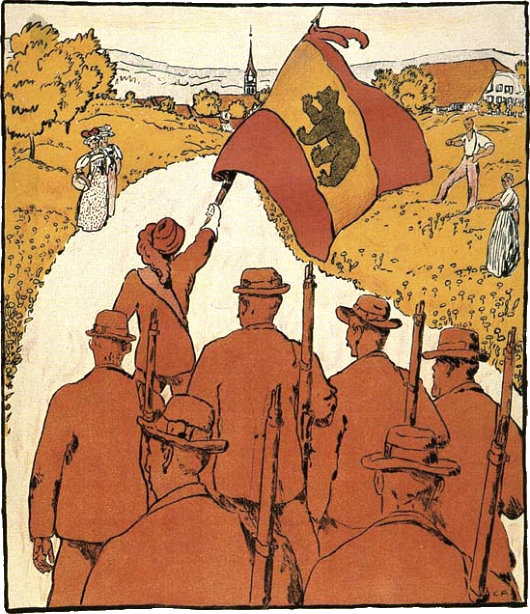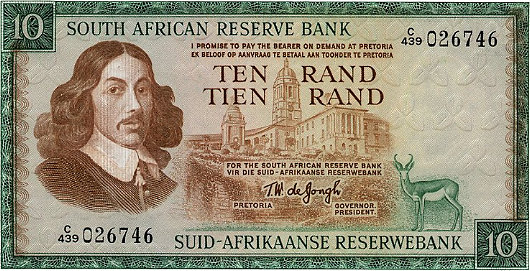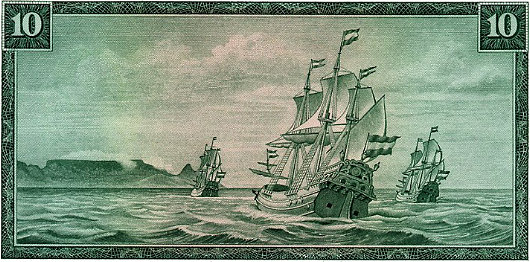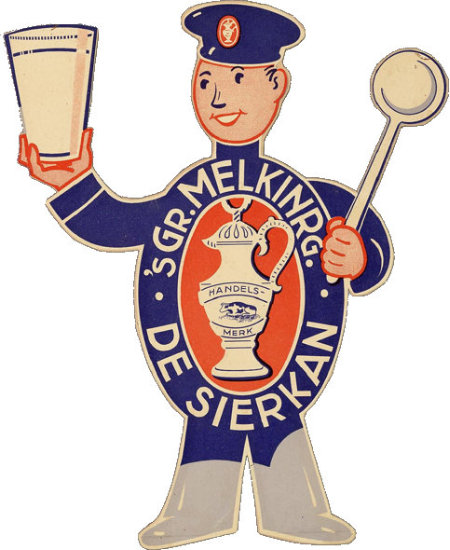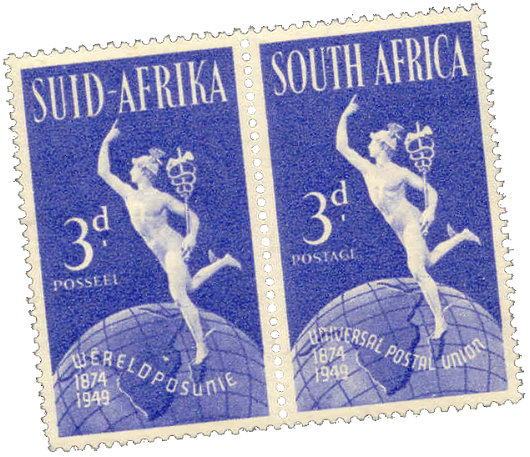Design
About Andrew Cusack
 Writer, web designer, etc.; born in New York; educated in Argentina, Scotland, and South Africa; now based in London.
Writer, web designer, etc.; born in New York; educated in Argentina, Scotland, and South Africa; now based in London. read more
News
Blogs
Reviews & Periodicals
Arts & Design
World
France
Mitteleuropa
Knickerbockers
Argentina
The Levant
Africa
Cape of Good Hope
Netherlands
Scandinavia
Québec
India
Muscovy
Germany
Academica
The Union Defence Force
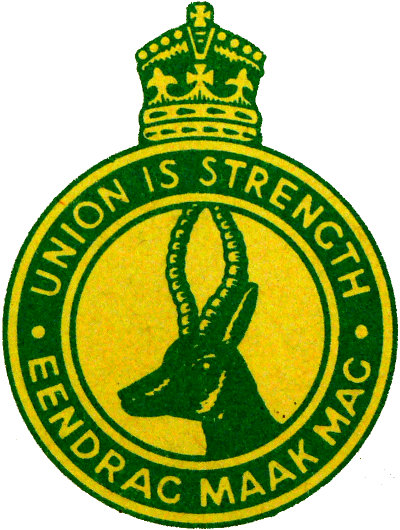
From 1912 to 1957, South Africa’s military was called the Union Defence Force (the Union in question being the Union of South Africa, the other USA). The Nationalist government renamed it the South African Defence Force (Suid-Afrikaanse Weermag) in 1957, prior to the declaration of the Republic of South Africa in 1961. After the introduction of universal suffrage in 1994, the SADF was merged with the MK (Umkhonto we Sizwe, the ANC’s terror branch) and APLA (Azanian People’s Liberation Army, the terrorist wing of the Pan-Africanist Congress), as well as the Self-Protection Units of Prince Mangosuthu Buthelezi’s Inkatha Freedom Party, into the South African National Defense Force (SANDF, or SANDEF), which remains the name of the country’s armed forces today.
Crosses Return to Columbia Crown
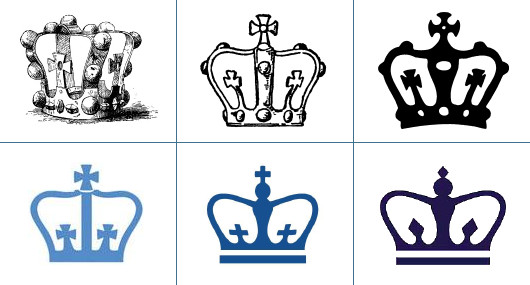
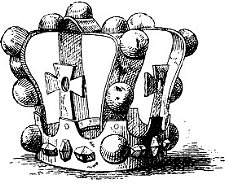 AFTER AN ABSENCE of some years, Columbia University has returned the crosses to its official crown emblem. The crosses had been missing since March 2004, when they were replaced with trapezoidal lozenges, but the more historic cross design has quietly returned to favour as the Ivy League institution’s official symbol. Columbia was founded in 1784, but claims the earlier heritage of King’s College, founded in 1754 but exiled to Nova Scotia, where it now has university status, after the tumult of the American Revolution. A copper crown (right) was originally attached to the cupola of College Hall, King’s College’s home in the colonial city of New York. When Columbia was founded in 1784, a year after New York’s independence was recognized, the state legislature gave the property and endowment of King’s College to the new Columbia College, which was organized by the remaining non-Loyalist members of King’s College. (more…)
AFTER AN ABSENCE of some years, Columbia University has returned the crosses to its official crown emblem. The crosses had been missing since March 2004, when they were replaced with trapezoidal lozenges, but the more historic cross design has quietly returned to favour as the Ivy League institution’s official symbol. Columbia was founded in 1784, but claims the earlier heritage of King’s College, founded in 1754 but exiled to Nova Scotia, where it now has university status, after the tumult of the American Revolution. A copper crown (right) was originally attached to the cupola of College Hall, King’s College’s home in the colonial city of New York. When Columbia was founded in 1784, a year after New York’s independence was recognized, the state legislature gave the property and endowment of King’s College to the new Columbia College, which was organized by the remaining non-Loyalist members of King’s College. (more…)
Die Koninkryk van die Swart Pelikaan
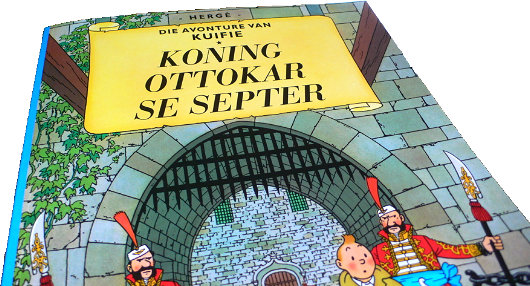
SYLDAVIA IS MY favourite country in the world. The buildings are old, the peasants are happy, and the king is ruling from his throne. Adding to my collection of Tintin books, the preponderance of which remain in New York, I know have three Afrikaans editions of Hergé’s works: Die Blou Lotus, Die Geheim van ‘De Eenhoorn’, and — my preferred among all the Tintin books — Koning Ottokar se Septer. Aside from Afrikaans, the rest of my copies are all either in French or English. I have a copy of the reprinted Tintin au Pays des Soviets and I just recently bought a copy of Tintin in the Congo, as I figured the European Union’s attempt to ban the book might make it harder to come by in years to come. I bought a copy of Le Sceptre d’Ottokar in a gas station in Brittany, one of the six special editions with a preface by Bernard Tordeur of the Hergé Foundation released in 1999/2000. Aside from Au Pays des Soviets & Le Sceptre, the only other French editions I have are L’Île Noire and Le Lotus bleu. (more…)
Austin Reed
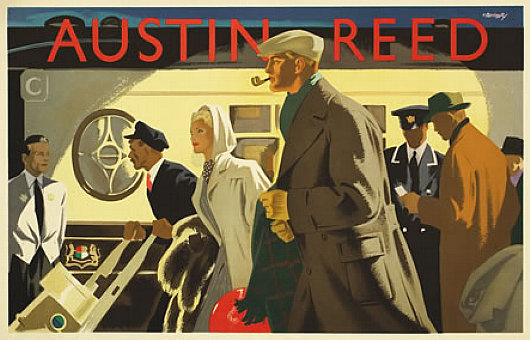
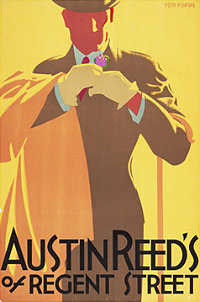 The London mens’ clothier Austin Reed was founded in 1900 and set up shop in Regent Street in 1926 as the first men’s department store. The clothes were aimed at the upper middle class male, and the firm commissioned some of the best illustrator-designers of the day to promote its brand. The above poster, “Wagon-Lits”, is by a designer named Bomarry, about whom I can find absolutely nothing — surprising in this Age of Google.
The London mens’ clothier Austin Reed was founded in 1900 and set up shop in Regent Street in 1926 as the first men’s department store. The clothes were aimed at the upper middle class male, and the firm commissioned some of the best illustrator-designers of the day to promote its brand. The above poster, “Wagon-Lits”, is by a designer named Bomarry, about whom I can find absolutely nothing — surprising in this Age of Google.
The remaining posters presented here are from the Bristol-born Tom Purvis, one of the finest commercial artists of the twentieth century. Purvis came from an artistic family, being the son of the sailor & nautical artist T. G. Purvis. Much of his output was work for LNER — the London & North Eastern Railway — producing posters advertising the various attractions to be found along the LNER’s routes from London to Edinburgh (via York & Newcastle) and on to Aberdeen and Inverness; the railway also had an extensive coverage of East Anglia. In 1936 he was among the first to be given the title of Royal Designer for Industry, but he gave up poster design after the Second World War to concentrate on portraits and religious themes. (more…)
Black Rod — Swart Roede
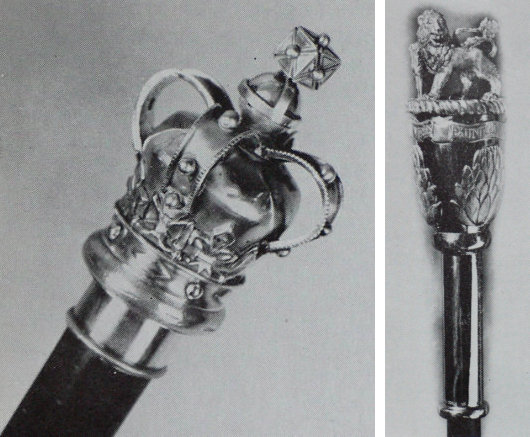
In my post on the 1947 Royal Visit to Cape Town, I mentioned just in passing the title of the Draer van Swart Roede — or the Gentleman Usher of the Black Rod, as he is known in English. Well, here is the Black Rod itself. The original South African Black Rod (left) dates from the Parliament of the Cape of Good Hope and was adopted as the Black Rod of the Union Parliament when South Africa was unified in 1910. After the abolition of the monarchy in 1961, a new Black Rod (right) was commissioned which featured protea flowers topped with the Lion crest from the South African coat of arms.
Black Rod (the person, not the staff) was the Senate’s equivalent of the House of Assembly’s sergeant-at-arms (ampswag). The first Gentleman Usher of the Black Rod in history was appointed in 1350 and the position still exists today in the British Parliament of today. Black Rod is sergeant-of-arms of the House of Lords, as well as Keeper of the Doors. The Usher’s best-known role is having the doors of the House of Commons ceremonially slammed in his face when he acts as the Crown’s messenger during each State Opening of Parliament, a ritual derived from the 1642 attempt of Charles I to arrest five members of parliament.
In South Africa, die Swart Roede traditionally wore wore a black two- or three-pointed cocked hat, a black cut-away tunic, knee breeches, silk stockings and silver-buckled shoes, but this costume of office has undergone a process of modernisation since the 1950s. After the vast expansion of the electorate in 1994 and introduction of an interim constitution, Black Rod’s title was officially shortened to “Usher of the Black Rod” to make it “gender-neutral”. (Regrettably, the Canadian Senate has also mimicked this innovation, though it is often unofficially ignored.) When a new, permanent constitution was enacted in 1997, the Senate was replaced by the National Council of Provinces as the upper house of parliament. A new Black Rod (the staff, not the person) was introduced in 2005, but is of such a garish design that it is best left uncommented upon.
Quebec Stamp
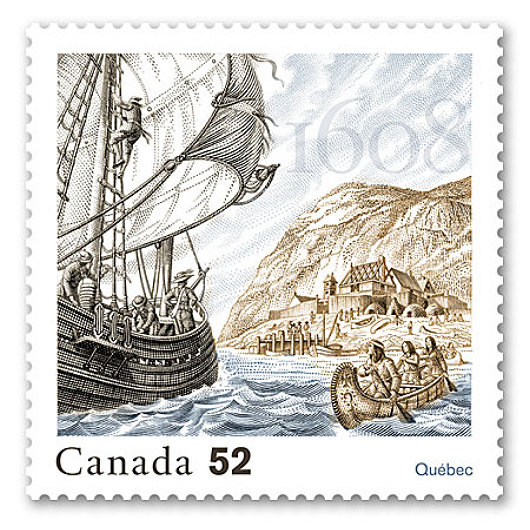
This stamp was designed by Jorge Peral, the artistic director of the Canadian Bank Note Company, for Canada Post to commemorate the four-hundredth anniversary of the foundation of Quebec.
The Goerke House, Lüderitz
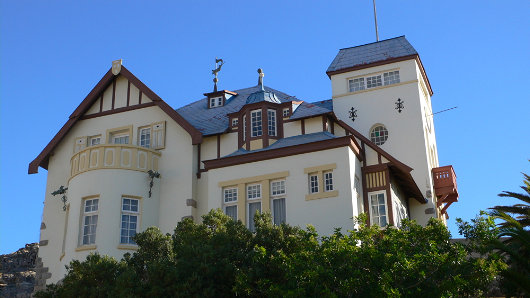
THE FAMILIAR PHRASE has a person in difficult circumstances being “between a rock and a hard place”. The Namibian town of Lüderitz is stuck between the dry sands of the desert and salt water of the South Atlantic — this is the only country whose drinking water is 100% recycled. Life in this almost-pleasant German colonial outpost on the most inhospitable coast in the world has always been something of a difficulty, but the allure of diamonds has at least made it profitable. One such adventurer who came from afar and made his fortune in this outer limit of the Teutonic domains was one Hans Goerke. (more…)
A new look for Argentina’s Herald

The Buenos Aires Herald is one of those newspapers that, by the grace of God, simply must continue existing no matter what horrors befall the newspaper industry as a whole. Finding up-to-date information on Argentina, in English, can be exceptionally frustrating and I had the Sunday version of the paper sent to me in New York every week; perfect reading for the train ride into work. Martin Gambarotta’s “Politics & Labour” column has to be one of the most informative and well-written political columns in any English-speaking newspaper. I also enjoyed the paid announcements section, informing readers of golf tournaments in aid of the Hospital Británico, meetings of the British-Argentine Chamber of Commerce, and when the next convocation of the South America Piping Association would be held. That said, when the Herald started denominating their subscription fee in dollars instead of pesos, I had to call it quits — though very reluctantly.
All the time while perusing the newspaper, however, I kept thinking “This could be better…”. Readers know how design-obsessed I am, especially when it comes to newspapers, and the Buenos Aires Herald would be such a better newspaper if they just tweaked a few things: a more judicious font choice, standardized white-spaces between columns, a few meliorations here and there. But now they’ve gone and redesigned the thing — without seeking the input of this devoted fan! — and they’ve got it all wrong. (more…)
St. Stephen and the Virgin & Child
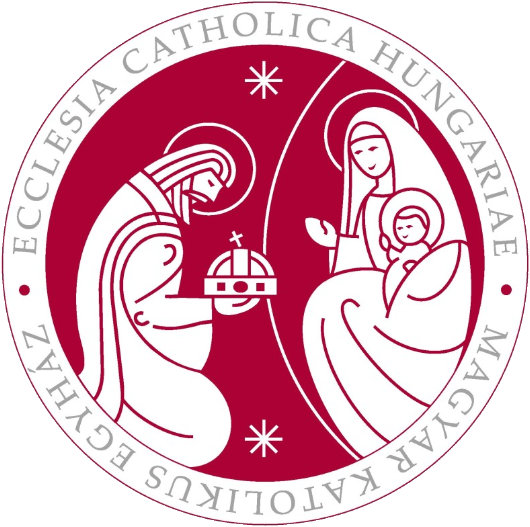
The Hungarian Bishops’ Conference has a surprisingly handsome logo (above) depicting their patronal saint, King Stephen I, bestowing his crown to the Blessed Virgin and Our Saviour. Some might think the depiction of the Madonna & Child a touch too cartoonish, but I enjoy it.
A new look for The Walrus

The Walrus is Canada’s general-interest magazine, a sort of New Yorker for the Great White North. Founded just a few years back in 2003, it has taken many of its visual cues from The New Yorker and the result has been a very handsome monthly and a surprisingly interesting one. That’s not to say that it’s a very interesting magazine (like The Spectator), but one which surprises with the occasional article of note. Canada’s intelligentsia is notoriously boring and liberal; they tend to sneer at the neighbouring United States while simultaneously attacking long-held Canadian traditions. For some reason, Canadian intellectuals have yet to comprehend that making Canada less British doesn’t make it more Canadian but instead more American because it is precisely Canada’s Britishness that distinguishes the Great Dominion from the republic to the south.
De Volkskrant
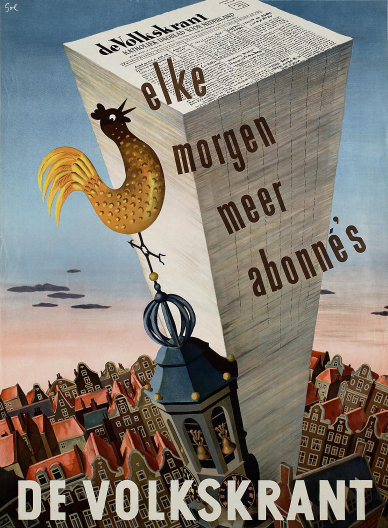
A FAVOURITE POSTER of mine combines a number of the things I love: newspapers, architecture, and the Netherlands. Arthur Goldsteen designed this handsome poster to advertise the daily newspaper De Volkskrant in 1950.
Fake Newspapers: “Bright Young Things”
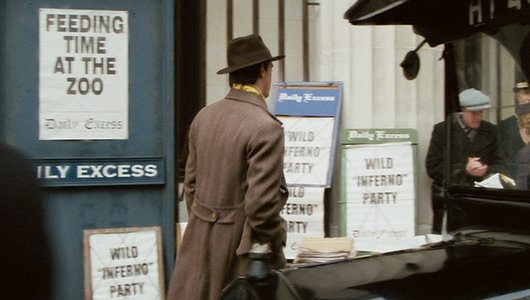
When it comes to newspapers, the visual element is all-important to an extent that shockingly few in the powerful parts of the industry comprehend. In the county of Westchester — my home turf — there is a monopoly when it comes to the newspaper as a means of local information delivery, and that monopoly belongs to the Gannett chain. Gannett newspapers are among the ugliest in the country, but then most American newspapers are abominations when it comes to design. The glory days of newspapers were, of course, the 1920s & 30s, and Stephen Fry’s film “Bright Young Things” — a rejigged dramatisation of Waugh’s Vile Bodies — highlights, as many Waughvian tales do, newspapers as a central plot instrument.
IHT Follow-up
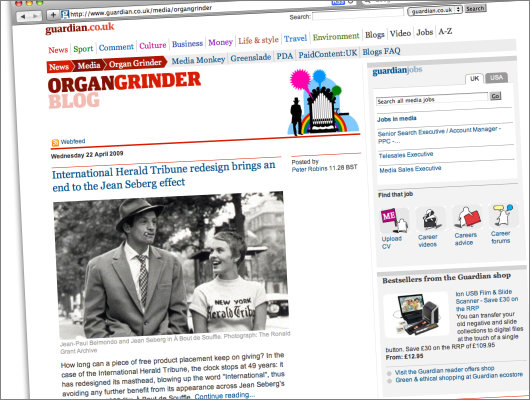
Writing about the latest changes over at the International Herald Tribune, the Guardian‘s media blog “Organgrinder” linked to our “remarkably comprehensive” post covering the subject in depth. I’m slightly embarrassed to say I’ve never seen any of Jean-Luc Godard’s films, something I will have to rectify through the DVD collection at the French Institute’s Haskell Library when I’m back in New York.
Meanwhile, Erik Zenhausern, the IHT’s former Operations Director for the Americas, corrects some errors on my part and gives us an inside look at NYT-IHT operations [boldface mine]:
Some things in the article may not be 100% accurate. The dingbat, along with the whole paper (it does mention the switch to Poynter type)was redesigned in 2002-2003.
Also, the New York Times does not own the print sites around the world where the IHT is printed. These are contract printers. Of course the entire supply chain is already set up so it will be easy to pump NYT lite throughout Europe and Asia and NYT doesn’t have the cost of maintaining these facilities.
I sat in on early strategy meetings when the NYT forced out the WP. Even in the first few months of owning the newspaper, many people at the NYT were ready to call the newspaper New York Times International. If it wasn’t for focus groups saying they thought anything that says “New York” on it won’t sell in europe.
While in the early days the tread lightly, heavier footsteps are coming. The IHT will definitely be folded into the NYT at some point.
Guinness: Advertising with Imagination
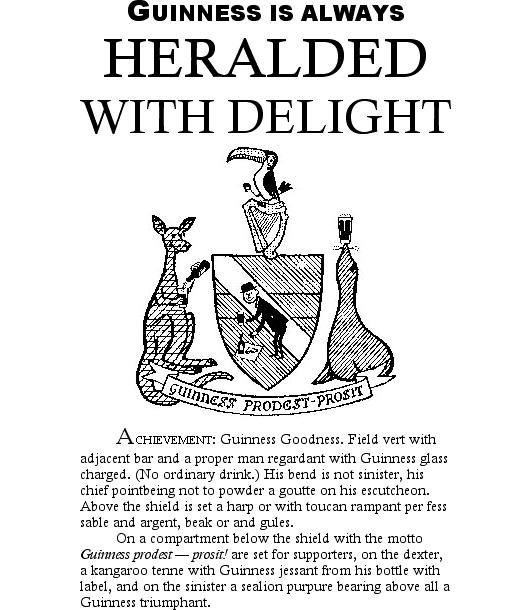
Cheshire heraldry expert Martin Goldstraw stumbled upon this creative ad for Guinness while stumbling through some old copies of The Coat of Arms, the journal of the Heraldry Society. [Mr. Goldstraw’s image modified by yours truly].
Among the heraldic terms employed in the text:
field
vert
bar
proper
regardant
charged
ordinary
bend
sinister
chief
goutte
escutcheon
rampant
sable
argent
or
gules
compartment
shield
motto
supporters
dexter
tenne
jessant
purpure
triumphant
The Scottish Executive, 1999-2007

While naturally relieved that Labour are no longer in charge, one of the few objections I have to the current SNP government in Scotland is that they changed the name of the Scottish Executive to “the Scottish Government”. The new name is just so damned boring. Every country, region, town, and borough has a “government”; it’s the dullest word you can come up with. But “the Scottish Executive” had such a nice ring to it. Listening to the evening news on Radio Scotland, one heard the newsreader speak of “the Scottish Executive” and immediately thought “Ah yes, that’s our part of the government!” Now one hears the sultry phrase “The Scottish Government today announced new measures…” and thinks “Oh, the government. Nobody likes the government.”
To add to this lamentable change, they even dumped the Scottish coat of arms as the visual identity of Scotland’s authority (as seen above, in the Executive days) and replaced it with an exceptionally dull saltire-flag logo that can be seen on the Scottish Government’s website.
Premier Salmond, give Scotland back her heraldry!
The Continued Decline & Fall of the International Herald Tribune
The New York Times ‘tightens the leash’, shutting IHT website and redesigning newspaper as Times-lite; Herald-Trib loyalists cry foul

THE SAD DECLINE of one of the newspaper world’s most historic titles is continuing as the entire industry faces the challenges of the twenty-first century. The International Herald Tribune recently suffered a host of changes on the order of its proprietor, the New York Times, that have continued to assault the Paris-based newspaper’s individual identity. The paper’s website, iht.com, has been shut down and now redirects to a new portal on the New York Times‘s website, nytimes.com. Non-U.S. internet viewers are now automatically sent to the new portal — global.nytimes.com — upon accessing the Times website as well, but can switch to the U.S. edition at the click of a button. The rationalization for the move is centered on the New York Times Company’s attempts to boost online advertising revenue as print advertising and sales figures tumble. Furthermore, the actual print version of the Herald-Tribune has been redesigned, spurning the paper’s long design identity to make it look like a more light-weight version of the New York Times.
Search
Instagram: @andcusack
Click here for my Instagram photos.Most Recent Posts
- Gellner’s Prague December 19, 2024
- Monsieur Bayrou December 18, 2024
- Dempsey Heiner, Art Critic December 17, 2024
- Vote AR December 16, 2024
- Articles of Note: 12 December 2024 December 12, 2024
Most Recent Comments
Book Wishlist
Monthly Archives
Categories

